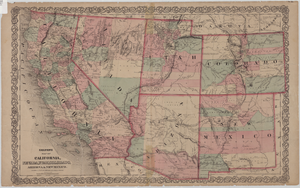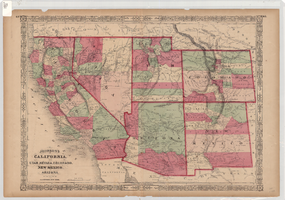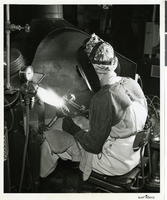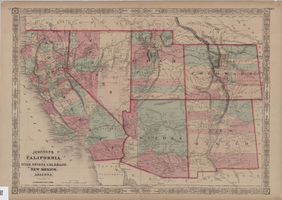Search the Special Collections and Archives Portal
Search Results
Howard Hughes, co-pilot Joseph Bartles, and navigator Robert Stevens at the controls of their Lockheed Constellation after landing at LaGuardia Field in New York City, 1946 February 15
Level of Description
Archival Collection
Collection Name: Howard Hughes Public Relations Photograph Collection
Box/Folder: Folder 20
Archival Component
Howard Hughes, co-pilot Joseph Bartles, and navigator Robert Stevens at the controls of their Lockheed Constellation after landing at LaGuardia Field in New York City, 1946 February 15
Level of Description
Archival Collection
Collection Name: Howard Hughes Public Relations Photograph Collection
Box/Folder: Folder 20
Archival Component

Map of California, Nevada, Utah, Colorado, Arizona & New Mexico, circa 1867
Date
Description
Image

Map of California, and territories of Utah, Nevada, Colorado, New Mexico and Arizona, 1864
Date
Description
Text

Photograph of new atomic-hydrogen welding process, Hughes Tool Company, Houston, Texas, circa 1929
Date
Archival Collection
Description
Image
Hughes H-1 Racer photographs, 1935-1945
Level of Description
Scope and Contents
Materials contain photographs of the Hughes H-1 Racer aircraft from 1935 to 1945. The photographs primarily depict Howard Hughes standing with the plane or in the plane's cockpit. The plane was designed by Glenn Odekirk and built by Hughes Aircraft Company in 1935, the first plane produced by the company. Hughes broke several records in the H-1, including the landplane speed record in 1935. In 1937, Hughes broke his own transcontinental speed record by flying from Los Angeles, California to New York City, New York in 7 hours, 28 minutes. Despite its speed, Hughes was unable to sell the H-1 to the U.S. military.
Archival Collection
Collection Name: Howard Hughes Professional and Aeronautical Photographs
Box/Folder: N/A
Archival Component
Restaurant in the Showboat Casino, Atlantic City, New Jersey, 1986
Level of Description
Archival Collection
Collection Name: Showboat Atlantic City Photograph Collection
Box/Folder: Folder 01
Archival Component
Gamblers in the Showboat Casino, Atlantic City, New Jersey, 1986
Level of Description
Archival Collection
Collection Name: Showboat Atlantic City Photograph Collection
Box/Folder: Folder 01
Archival Component

Map of California, Utah, Nevada, Colorado, New Mexico and Arizona, circa 1867
Date
Description
Image
Wilbur and Toni Clark at a formal dinner at the Hotel Astor in New York City, New York, 1958
Level of Description
Archival Collection
Collection Name: Toni and Wilbur Clark Photographs
Box/Folder: Folder 10
Archival Component
